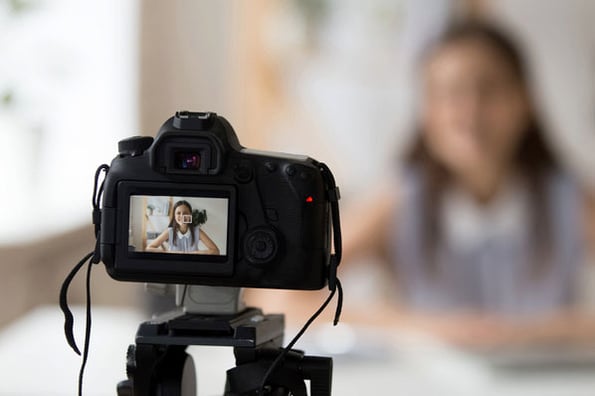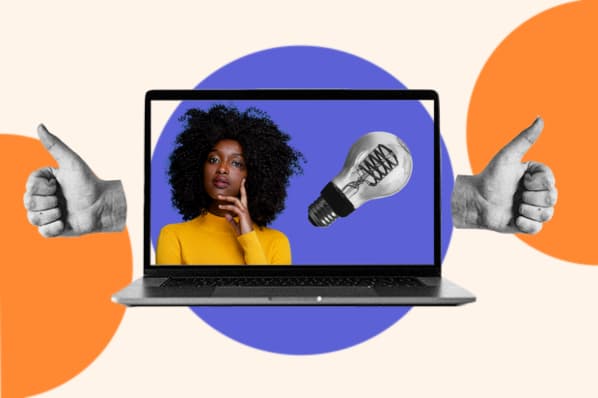In our 2020 State of Marketing report, video beat out common tactics like blogging and SEO as the most heavily prioritized marketing strategy for businesses this year.

The growth in video marketing isn't all that shocking. Today, video is dominating the internet -- especially on social media. And, throughout the last decade, social media platforms like Reddit and Facebook have changed dramatically to favor video over other content.
At this point, while tactics like blogging and advertisements are still vital to success, many groups, such as millennials or Gen Z prefer to learn about products, topics, or people through video.
But, as the trend of video marketing continues to grow, so does the number of companies opting into remote work. If you're in a company that is quickly taking its processes out-of-office or a video marketer who's always wanted to try working remotely, you might be wondering, "Can I actually make a marketing video from remotely?"
The question of whether videos can be filmed anywhere is definitely valid. After all, high-quality videos do require you to film in an optimal location that's quiet, looks aesthetically pleasing, and has good lighting. And, if you're less familiar with the process of creating scalable videos, you might envision that you'd need a perfect film studio filled with a camera crew, makeup artists, and expensive equipment.
The truth is, marketing videos can cost you some time and money. However, many of them can be quite scaleable and filmed in all sorts of locations.
In 2020, we're already seeing a number of brands and influencers market products or services through social media or online videos filmed in their own home or a remote location nearby.
But, what's the best way to navigate filming marketing videos from home? The first step could be deciding on a video format that's both scalable and feasible to create from multiple locations.
In this blog post, I'll highlight three types of videos that marketers can easily film from home while showing you a few examples. In the conclusion of this piece, I'll highlight a few tips for creating quality videos from anywhere.
3 Types of Marketing Videos You Can Film Remotely
Demos or Tutorials
For years, startup founders have been filming demos and tutorials in home offices, shared workspaces, or screen-share videos. Because the center point of a demo or tutorial is a product or process, viewers' eyes will be locked on that. While you should film in an environment with a non-distracting background, limited noise, and good lighting so the viewer can properly focus on the demonstration, you can zoom in on the product for most of the video and don't necessarily need studio lighting or a pricey background to please viewers.
One example of a brand that has embraced the at-home tutorial for years is Kylie Cosmetics. Although the company does have offices in Los Angeles, Kylie Jenner or members of her marketing team will often film makeup tutorials for Instagram in a home setting.
Here's one example of a demo video Kylie Cosmetics published on IGTV.
In a way, these makeup tutorials make the brand and product feel more authentic. Because they're filmed in natural, but still strong, lighting, the tutorials better highlight what the products will look like on a person in real life. This can be hard for customers to determine when viewing highly edited product shots of makeup.
If you're trying to highlight something that isn't a physical product, such as software or digital services, you can also consider an animated demo or screen-recorded video that shows how your product works or highlights the digital services you offer clients. This might add extra editing time to your video production, but it eliminates the need to prepare your workspace for a film shoot.
Here's a great demo from SurveyMonkey, which combines screen grab images with animation to show the ins and outs of its survey products:
Within two minutes, SurveyMonkey demonstrates how easy it is to use its products and how it can integrate with other common office tools like Slack.
Explainers
An explainer allows you or a credible person affiliated with your business to explain a product offering or a topic related to your industry. For example, explainers could discuss a piece of industry news, a new trend, winning strategies related to your industry, or even tactics to avoid. Or, if your business is too complex for a basic demo or tutorial, you could film explainer discussing an important strategy and how your business could benefit it.
Explainers are slightly different from tutorials or demos in that they focus on explaining a complex topic or strategy, rather than just demonstrating how to use a product.
Although an explainer doesn't need to specifically discuss your product, this format allows you to show your audience that you have expertise in the industry that your product is in. Additionally, if you have access to a known thought leader or influencer that can film an explainer for you, audiences of your brand and that person could see the video and think your brand is more credible because a well-known expert is associated with your content.
There are multiple ways to film an explainer. The most basic type could involve filming yourself or a thought leader talking to the camera about the topic while standing in front of a basic background or whiteboard. Additionally, you could use a free tool like HubSpot's Clip Creator and its templates to create an effective explainer video with minimal equipment. To add some depth to this type of video, you could then edit it to include text or visuals that note other facts not explained on camera.
While this explainer was filmed in HubSpot offices, those in it are simply speaking in front of casual basic backgrounds. To zest up the video format and further inform the viewer, the editor added simple transitions, related images, and data visualizations:
Although the explainer above's primary goal is to explain email marketing to viewers, it also nicely wraps a shoutout for HubSpot Academy's email marketing course. This makes the video informative and a solid marketing tool.
If you or someone on your team knows graphic design or how to animate videos, you could also consider an explainer that relies on only graphics. While this type of explainer will take more time, it will eliminate the need for prepping a home or remote location for a video shoot.
Here's a great explainer on how artificial intelligence works from the emerging technology company Qualcomm:
Expert Q&As
Recently, a number of brands have been experimenting with pre-recorded or live Q&A videos. These videos allow an expert that's part of the brand or an industry influencer or thought leader to answer questions either asked by a host or an audience of commenters -- if the video is live.
Like explainers, these videos allow experts affiliated with the brand to share their knowledge, which can make the brand seem more credible. If the questions asked to the expert are commonly asked about the industry topic discussed, the audience will also get solid value from the content and consider the brand as a trusted resource. Additionally, if the video features an influencer or thought leader, their audiences might tune in and incidentally learn more about your brand.
Currently, there are a number of ways to do a Q&A that doesn't require a stage and people sitting next to each other.
For example, HubSpot, which has over 300 full-time remote employees will collect questions from its audiences and ask its in-house experts to answer them via Instagram Stories. With this strategy, the expert can film themselves with a smartphone in a location they prefer and send their best clips to our social media team. Then, the social team can easily publish the content on Stories:


More recently, it's also become more acceptable to perform pre-recorded interviews via video calls. This could allow a host and an influencer or a host and another expert on your team to perform an interview from separate locations.
Below is an example of a Facebook Live Q&A where a rep from Healthier Lifestyle 4 You, a company that sells wellness products, remotely interviews a health expert about alkaline water.
Although many brands are opting to do Q&A on live streams, you can alternatively pre-record your interview. This will enable you to edit the footage as needed, add transitions, and overlay useful text or captions.
Filming Remote Marketing Videos
Now that you've gotten a few examples of how brands filmed marketing videos affordably and remotely, you might be ready to get started on your own.
As you prepare to shoot your first video, keep these tips in mind:
Pick the right equipment: Although filming from home could save you more money than in a studio, you'll still want to invest in equipment as needed. For example, if you're filming an Instagram video and have a low budget, using a smartphone with a solid camera might do the trick. If you want to amp up the quality, you should consider purchasing a digital photo or video camera which will allow you to film with high resolution and adjust your environment's white balance. You might also want to purchase a microphone if your home is in a noisy location or an affordable floodlight if your home doesn't have strong natural light and you don't have lamps or extra lighting fixtures to work with.
Leverage your software: You don't need expensive software to edit a video, film a screen share video, or record a Zoom Q&A. The truth is, many apps that allow you to do these things are free, might already be installed on your laptop, or incredibly affordable. For example, Mac users have iMovie pre-installed while you can download a number of screen-recording apps out there.
To learn more about the ins and outs of marketing videos, check out this guide. For a list of affordable video editing software and apps, read this blog post.
![→ Access Now: Video Marketing Starter Pack [Free Kit]](https://no-cache.hubspot.com/cta/default/53/8f27c677-d952-4663-8787-bf65c6a1ecf2.png)

![How Brands Are Investing in Video Marketing on a Budget [2024 Data]](https://www.hubspot.com/hubfs/affordable-video-marketing-1-20241213-2175845.webp)

![Best Times to Post on YouTube in 2025 [Research]](https://www.hubspot.com/hubfs/best-time-to-post-youtube.jpg)

![The HubSpot Blog’s 2024 Video Marketing Report [Data from 500+ Video Marketers]](https://www.hubspot.com/hubfs/video-marketing-report.webp)




